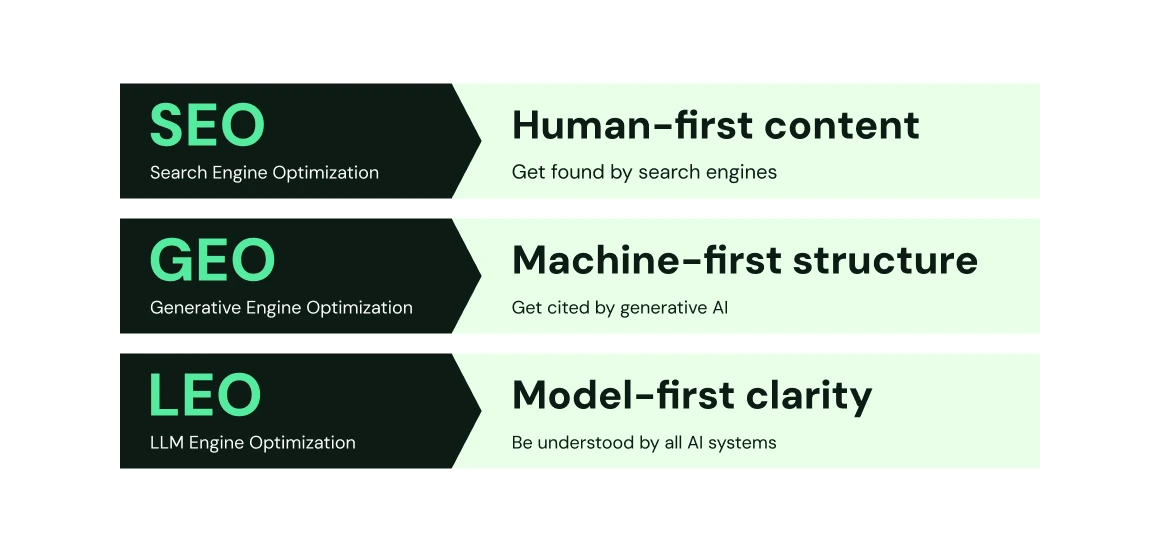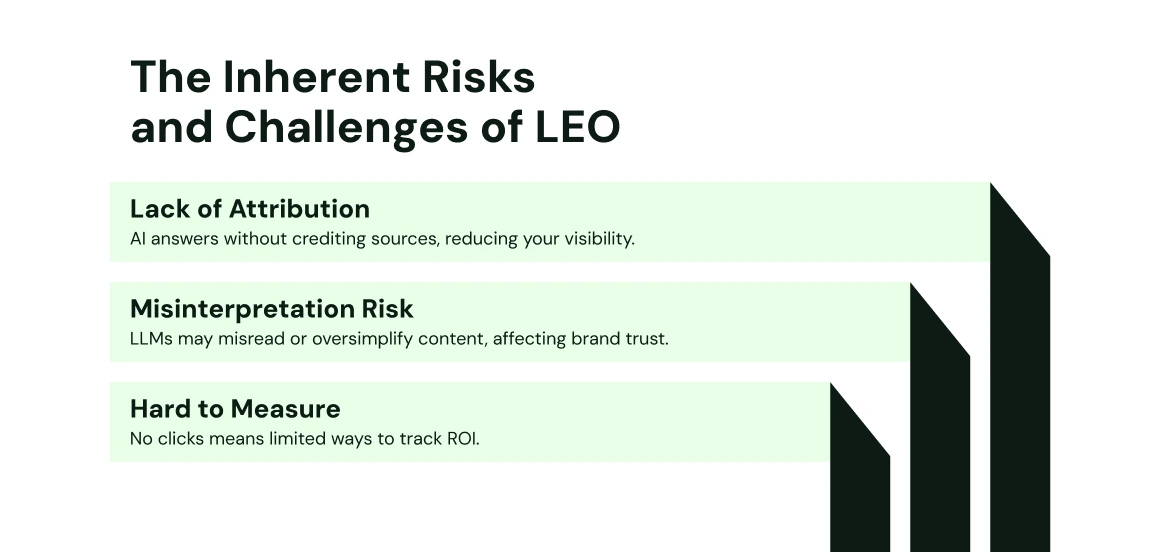August 23, 2025
|9 minute read

The shift to AI-powered search is happening faster than many B2B marketers and business leaders anticipate. As of March 2025, 13.1% of all U.S. desktop search results include an AI Overview, a number that more than doubled in just two months (Semrush, 2025).
For knowledge-heavy verticals such as healthcare, legal, and technology, this percentage is significantly higher, as generative summaries become the default response to informational queries.
This transformation is already affecting how users interact with content and how brands are discovered. A study by Raptive found that the presence of AI-generated answers can lead to a 25% decline in website clicks for top-ranking pages (Raptive, 2024).
However, in the B2B sector, the implications go deeper than lost traffic — it’s LEO (LLM Engine Optimization).about lost relevance in the buying journey.
Additionally, Forrester predicts that by the end of 2025, 45% of B2B decision-makers will use conversational AI tools like ChatGPT or Copilot during the research and vendor comparison phase (Forrester, 2024).
This makes mastering LLM Engine Optimization (LEO) not just an SEO add-on, but a core competitive advantage. In a world where AI decides which brands are credible, being the AI’s answer becomes the new measure of visibility.
The foundational contract between a business and its customer online has changed. For two decades, the agreement was simple: a customer asks a question, and a search engine provides a list of potential answers to click. That era is over.
Today, the digital landscape is dominated by Large Language Models (LLMs)—AI systems trained on vast amounts of text to understand and generate human language.
These LLMs power two transformative types of search experiences:
The result is that customers now expect instant, definitive answers, not just a list of options. This shift has fundamentally altered how they discover brands and find information.
For business leaders, the question is no longer “How do we get a click?” but “How do we become the answer?”
The discipline that addresses this new reality is LEO (LLM Engine Optimization).
LEO (LLM Engine Optimization) refers to the practice of optimizing content, data, or interactions specifically for Large Language Models (LLMs) — like ChatGPT, Claude, or Gemini — rather than traditional search engines like Google or Bing.
As users increasingly turn to LLMs to answer queries, make decisions, and summarize information,LEO is emerging as the next evolution of SEO (Search Engine Optimization)— but for AI-powered engines instead of web crawlers.

The decline in traditional clicks, while concerning, hides a more important truth: AI-influenced traffic converts better.
Studies say visitors who arrive via an AI-generated recommendation can be up to 4.4 times more valuable than standard search visitors because they come withhigher trust and stronger intent(Semrush, 2025).
A 2025 B2B Benchmark Report supports this shift in behavior: leads that mention AI-generated product suggestions during form submissions or demos convert 34% faster and are 2.3 times more likely to reach the pipeline stage than traditional SEO-driven leads (ZoomInfo, 2025).
This reinforces the case for apeople-first LEO strategy — one built on transparency, usefulness, and digital trust. You can’t game an AI whose objective is to serve users. The only path forward is to align with that goal: delivering themost helpful, accurate, and authoritative content.
By focusing on your audience’s true questions and pain points, you signalreal-world expertise— something LLMs are increasingly trained to detect and prioritize. The result is not just higher visibility in AI-generated answers, but along-term strategic asset: your brand’s reputation as a definitive, trustworthy voice in your market.
LEO impacts your visibility across a new and growing ecosystem of “answer engines.” The most prominent examples as of mid-2025 include:
A successful LEO strategy translates this people-first principle into five core actions.
LLMs are designed to prioritize content that demonstrates Experience, Expertise, Authoritativeness, and Trustworthiness (E-E-A-T).
Action: Go beyond generic content. Publish proprietary data, unique industry analysis, and case studies that showcase your firsthand experience. Feature named authors with credible backgrounds and link to their expert profiles.
Your expertise must be clear to a machine.
Action: Use a logical heading structure, short paragraphs, and bulleted lists. ImplementSchema Markup—a type of code that acts as “invisible labels” to explicitly tell an AI what your content is about (e.g., this is an FAQ, this is a product review).
LLMs understand the world through “entities”—specific people, places, brands, and concepts.
Action: Strengthen your brand as an entity by ensuring your company name and details are consistent across the web. Focus on earningbrand mentions in reputable third-party content like news articles and industry blogs, as these are powerful signals of authority.
Users turn to AI for answers, not essays.
Action: Dedicate content to answering the specific, conversational questions your customers are asking. Use tools to find “People Also Ask” queries and forum discussions on sites like Reddit and Quora, and then create the best, most comprehensive answers.
An LLM’s understanding of your brand is not limited to your website. It synthesizes information from your entire digital footprint.
Action: Actively monitor and manage your online reputation. Your customer reviews, news coverage, and social media presence all contribute to the AI’s perception of your trustworthiness. Engaging positively across these platforms is a core LEO activity.
LEO isn’t just a content checklist — it’s a cross-functional business strategy.
It requires collaboration between yourSEO, content, PR, and internal subject matter experts. The goal isn’t just to publish more content; it’s to build public authority that AI tools can recognize and rely on.
LEO should be seen not as a marketing expense, but as a strategic investment in your company’s AI-era reputation.

As with any emerging discipline, LEO comes with challenges:
While challenging, measurement is not impossible. The focus must shift from direct clicks to influence and authority.
Key Performance Indicators (KPIs) should include:
An effective LEO strategy must also look ahead. AI is increasinglymulti-modal, meaning it analyzes more than just text—it understands images, video, and audio (Google AI). Optimizing these formats is the next frontier. This includes:
For Videos: Providing detailed, text-based descriptions and transcripts.
For Images: Use highly descriptive alt-text and file names that explain what the image shows.
For Podcasts: Publish full transcripts that an AI can read.
LEO is not just about visibility. It’s about becoming a trusted source of truth in your industry. It rewards content that is credible, helpful, and clearly authored, not just clickable.
The brands that adapt will do more than survive. They will thrive as the go-to answer, not just in search engines, but in the minds of AI and their users.
Works Cited
Please enter your email address so we can send you a one-time pass code and verify if you are an existing subscriber.